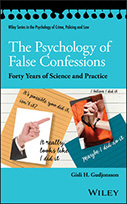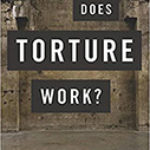The Psychology Of False Confessions: Forty Years Of Science And Practice

Author: Gisli H. Gudjonsson
Publisher: Hoboken, NJ: Wiley & Sons, Ltd., 2018. 552p.
Reviewer: Melanie Clark Mogavero | March 2020
The Psychology of False Confessions: Forty Years of Science and Practice by Gisli H. Gudjonsson is a comprehensive and up-to-date compilation of the scientific research into the complexities surrounding one of the most intriguing law-related phenomena, namely, falsely confessing to a crime one did not commit. The book is organized in three parts: Part 1 (Chapters 1-5)- The Emerging Science and Practice, Part 2 (Chapters 6-12)- The Gudmundur and Geirfinnur Cases, and Part 3 (Chapters 13-18)- A Psychological Analysis of the Confessions of the Six Convicted Persons.
This book is the third book in a series. The first book, The Psychology of Interrogations, Confessions, and Testimony was published in 1992, and the follow up Psychology of False Confessions: A Handbook, in 2002. In this third book, Gudjonsson, an Icelandic forensic psychologist and former detective, adds the results of a re-opened case of Iceland’s two most infamous murders, the Gudmundur and Geirfinnur cases, and his analyses of the confessions of the six individuals convicted in those cases.
In the Introduction, Gudjonsson brings the reader back to his early career as a psychology student and his summer job working with the local police. While questioning a male suspect accused of stealing a purse, he unintentionally elicited a false confession from him. At this time, little was known about false confessions or why an innocent person would falsely confess. This experience helped launch the trajectory of Gudjonsson’s career, as he went on to become a world-renowned expert in the field of false confessions.
Chapter 1 focuses on the author’s early inquiry into topics related to confessions, including research development, real life cases, police practices, and empirical research on false confessions. In Chapter 2, Gudjonsson highlights six high-profile landmark cases that resulted in significant changes to the law in the U.K., including the so-called Confait case, where 18-year-old Peter Reilly and three others were convicted and later exonerated in the murder of one Maxwell Confait; and the “Guilford four” and the “Birmingham six” cases where ten men were convicted and later exonerated of multiple murders resulting from two separate bombings of public houses in Birmingham and Guilford, England. These cases brought about change in the admissibility of, attitudes toward, and receptiveness to expert psychological evidence. For example, the Confait case led to setting up the royal commission on criminal procedure. The acquittals of the Guilford four increased awareness of police misconduct and the psychological vulnerabilities of suspects during interviews. The so-called PEACE model of interviewing was developed and implemented in response to the injustices resulting from problematic interviewing. Gudjonsson notes that the PEACE model was developed from sound psychological principles, intended to take into consideration the vulnerabilities of some suspects; and he contrasts this with the guilt-presumptive Reid technique commonly used in the U.S.
In chapters 3 and 4, Gudjonsson provides a full theoretical framework of the theories and explanations of false confessions. Beginning with suggestibility, which Gudjonsson states is intrinsic in all theories of false confessions, he summarizes research on suggestibility and the development of his suggestibility scales (Gudjonsson Suggestibility Scale 1 and Gudjonsson Suggestibility Scale 2). Suggestibility is the idea that leading questions can illicit expected answers, falling into two types: immediate and delayed. Immediate suggestibility refers to the immediate response one gives after a leading question, whereas delayed refers to the extent to which one later incorporates misleading information into their recollection. These chapters help the reader better understand the reasons why one would give a false confession, and the reader can imagine themselves being in the interrogation room. This allows the reader to begin to understand how stressful the interrogation process can be, and how one can easily be tricked into confessing via interrogation techniques. For example, the interrogator may suggest memory problems, which can lead suspects to question their own memory. Trusting and vulnerable suspects may develop what is called memory distrust syndrome.
Gudjonsson presents the empirical research on interrogation practices and false confessions in three groupings: the history and the origins of examining false confessions and then how, over time, false confessions became an area of scientific study, including the formation of the Gudjonsson Suggestibility Scales. The discussion contains dozens of empirical research examples spanning decades, with a wide variety of methodologies, including field observations, qualitative interviews, surveys, and laboratory experiments. These decades of research have revealed that false confessions are caused by a combination of factors, which fall roughly into being “situational” (e.g., interrogation tactics, custodial environment, detainment, isolation) or “personal” (e.g., age, gender, race, intellectual disability, mental illness).
Some of the personal factors found in the research are related to age and mental status. Juveniles are more likely to falsely confess than adults, as they are less able to resist police pressures and tactics, due to their immaturity. Other factors that increase the risk of false confessions include having severe mental illness, an intellectual disability (e.g., low IQ), Attention Deficit Hyperactivity Disorder (ADHD), substance abuse, a history of trauma/abuse, and PTSD. Gudjonsson details the problems with police interrogation techniques on vulnerable populations as well as other common reasons suspects confess to crimes they did not commit.
In Part two, the author shifts the focus to the aforementioned decades old Icelandic murder cases, which were re-opened when new evidence came to light. The cases in question were the 1974 disappearance of two young men, Gudmundur Einarsson and Geirfinnur Einarsson (no relation). The police investigations into the cases were widely based on rumors and assumptions, which led to the interrogations, arrests, and convictions of six individuals, all of whom were acquainted: Saevar Ciesielski, Erla Bolladottir, Gudjón Skarphédinsson, Tryggvi Leifsson, Krisjan Vidarsson, and Albert Skaftason. The bodies of Gudmundur and Geirfinnur have never been found, and there was no forensic evidence to link any of the six suspects to the cases.
Chapter 6 begins with an overview of the Icelandic society, economy, and politics during the decade in which the alleged murders occurred. In the 1970s, Iceland was experiencing a problem with alcohol and drug smuggling, and saw an increase in homicide rates. This led to increased fear among citizens, who for decades enjoyed a relatively peaceful society. These presumed murders led to a public outcry to find the killers and bring them to justice. The police were under immense pressure to solve the cases. The code of legal practice at the time, which dated back to the early 1950s, emphasized open-mindedness and fairness in the treatment of suspects. In the Gudmundur and Geirfinnur cases, however, this practice was not upheld, seemingly due to the political and societal pressures.
Gudjonsson provides extensive details about the disappearance and presumed murders of Geirfinnur and Gudmundur. The two cases were linked, mainly by rumor, which “contaminated” the investigative team. Gudjonsson (as he does throughout the book) provides a timeline on the cases and a chronology of the details of the investigation. Indeed, he worked as a detective in the Gudmundur case. He provides details of the disturbing interrogations of all six individuals. All six suspects were subject to (although it varied) lengthy bouts of solitary confinement and numerous interrogations, many of which spanned many hours.
The statements the suspects gave during the interrogations were vague, inconsistent, lacked tangible details that could not be corroborated, and provided no substance to the case. In addition, several repeatedly changed their statements or recanted their confessions. The investigative team found themselves in a predicament, which led to the appointment of a German investigator to assist with the case, one Karl Schütz. Gudjonsson devotes an entire chapter to Schütz, beginning with his background and how he came to be appointed to the case. Schütz utilized interrogation techniques that were not only inconsistent with Icelandic legal code, but that had questionable effectiveness, as they involved trickery, questions that did not follow sequential order, and that were guilt presumptive. Gudjonsson details a number of problems with Schütz overseeing the case, including the amount of autonomy he was given.
At first, the reader may be unsure why the author draws so much attention to these decades old cases. In 2011, three diaries of the since deceased Tryggvi Leifsson were uncovered by his widow, and given to a TV reporter. The reporter then launched her own investigation into the Geirfinnur case, as she believed innocent people had been convicted. Gudjonsson met with this reporter and with Tryggvi’s daughter. These efforts led to the formation of the Case Review Commission to look into both cases. A working group was established to review the cases, and Gudjonsson was appointed as an expert. Here, the author provides a detailed summary and timeline of the formation and progress of the Case Review Committee from 2011 to 2018. He also details the methodology of the Working Group, the general findings, the court testimony, and the findings from the Court Case Review Commission. The result — significant problems were uncovered regarding the investigation, evidence, and the confessions of all six suspects convicted in the cases.
Gudjonsson provides detailed psychological analyses of the interrogations and confessions of the six individuals involved. All six endured shocking and inhumane treatment during their confinement and interrogations. His analysis includes information from their childhood, any history of alcohol or substance abuse, any previous diagnoses, and symptoms and characteristics consistent with disorders such as ADHD, depression, or PTSD. He also explains how these factors may have influenced their experiences during the interrogations and how they coped with solitary confinement. With this information, Gudjonsson details the various personal and situational factors surrounding the confessions of the six suspects and provides conceptual models for each that explained their confessions. Each model contains the context or “triggers” for breaking down resistance (e.g., isolation, persuasive interrogation techniques), enduring factors, (i.e., personal factors regarding their history), and acute factors, which refer to the factors present during the interrogation.
The foundation of empirical research on risk factors associated with false confessions provided in Part 1 helps the reader understand the case details. For example, Gudjonsson suspected that Tryggvi Leifsson, who was convicted of manslaughter in the Gudmundur case, had various conditions that affected his ability to cope with the interrogation and confinement. His psychiatric evaluation revealed he had low average intellectual functioning, symptoms of ADHD, and a history of alcohol abuse. His alcohol abuse made him susceptible to developing memory distrust syndrome when interrogators challenged his memory (interrogators also questioned Erla Bolladottir’s memory using similar tactics). As a consequence of all this, Leifsson gradually began to distrust his memory of not being involved in the Gudmundur case.
Erla Bolladottir was in solitary confinement for 241 days on two separate occasions and spent 142 days in prison. She was questioned by the police some 105 times totaling 120 hours. She was particularly vulnerable because of her youth, a history of sexual abuse, and the fact that she had a newborn baby to whom she was eager to return. The author concludes that she too suffered from memory distress syndrome that was brought about by the intensive persuasive interrogations, her enduring vulnerabilities and several situational factors including her desperation to be with her newborn. Having considered the evidence in both cases, Gudjonsson concludes that all six confessions were unreliable and they all were likely innocent.
These shocking cases of innocent people confessing to crimes they did not commit during police interrogations certainly makes the reader question the presumptive guilt tactics used in the U.S. The author cites research highlighting a number of false confessions in the U.S. and questions the use of psychologically coercive interrogation methods.
Gisli Gudjonsson explains how these miscarriages of justice could happen to six innocent people. The alleged crimes occurred in the mid-1970s, the investigation continued through the late 1970s and their convictions in 1980. In that historical context, little was known about the psychology of false confessions, and there was general reluctance to believe that a suspect would falsely confess to a serious crime he or she did not commit. The concept of memory distress syndrome is only one of many interacting factors that can result in a false confession. Depending on the models developed and illustrated in this book, the custodial risk factors may interact with the enduring and acute vulnerability factors. As Gudjonsson demonstrates, false confessions are not limited to juveniles or those with intellectual disabilities. There are many situational and personal risk factors that may increase one’s vulnerability during interrogations.
Gudjonsson offers 11 suggestions for best practices to reduce false confessions during the early stages of an investigation, including the dangers of using solitary confinement or having suspects or witnesses have to wait for hours before being questioned.
The Psychology of False Confessions: Forty Years of Science and Practice crosses several scientific disciplines and should interest a vast audience, including attorneys, police and other criminal justice system practitioners, legal analysts, criminologists, sociologists, psychologists, and social workers. Because the book covers diverse topics, including a theoretical framework and empirical research on false confessions, it will be a valuable resource for any who want to better understand the phenomena of false confessions.
Melanie Clark Mogavero, Ph.D., Assistant Professor of Criminal Justice, Georgian Court University


